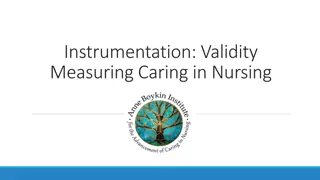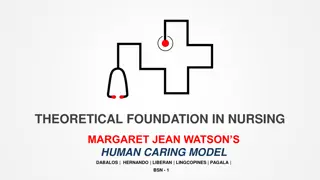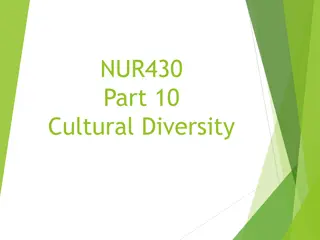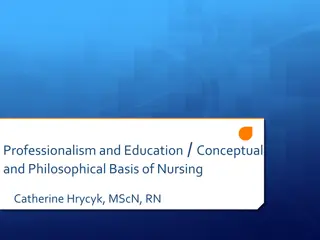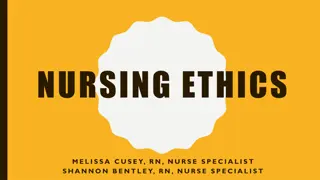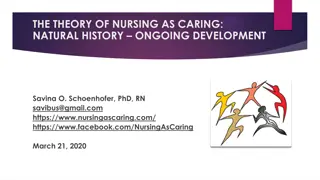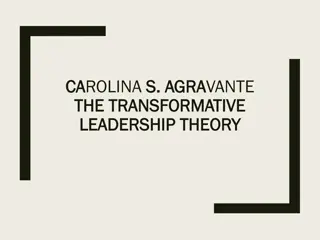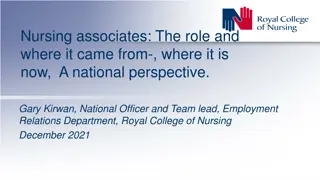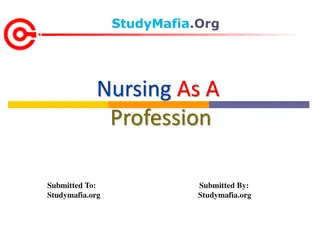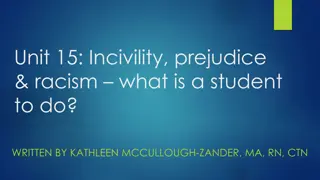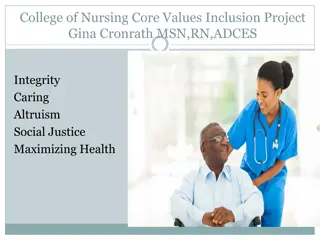Evolution of Bureaucratic Caring Theory in Nursing
Discussion of the Theory of Bureaucratic Caring by Marilyn A. Dee Ray, focusing on the systematic integration of purposeful concepts and the development process of the BCT model. The research explores the meaning of caring within institutional culture using methodologies like ethnography and phenomenology. The presentation showcases the evolutionary process and domains of caring identified in the theory.
Uploaded on Jul 18, 2024 | 0 Views
Download Presentation

Please find below an Image/Link to download the presentation.
The content on the website is provided AS IS for your information and personal use only. It may not be sold, licensed, or shared on other websites without obtaining consent from the author. Download presentation by click this link. If you encounter any issues during the download, it is possible that the publisher has removed the file from their server.
E N D
Presentation Transcript
International Association for Human Caring Evolution of Ray s Theory of Bureaucratic Caring By Marilyn A. Dee Ray, RN, PhD, CTN-A, FSfAA, FAAN, FESPCH, FNAP, HSGAHN, Hon. LL. D. Professor Emeritus, Florida Atlantic University, Christine E. Lynn College of Nursing, Boca Raton, Florida 2022 1
Goals of Presentation of Theory of Bureaucratic Caring To discuss theory (systematic integration of purposeful concepts, domains, dimensions) and the nature of theorizing (reflection/analysis) Use of Ethnography (participant-observation of cultural phenomena (values, beliefs, behaviors of caring) of human-organizational life; Phenomenology (oriented to practice-reflection and seeing meaning of life world human caring experience); Grounded theory (systematic process of the human relational social-caring context identification of objective features of the subjectivities of meaning of experience/events) To present the process of theory and model development of the Theory of Bureaucratic Caring (BCT) initially from analysis of 192 diverse participants. To identify and illustrate the meaning of the 8 domains of caring identified in the theory from research of the meaning of caring. To reveal the evolutionary USAF and DHA process of development (the USAF, NC Professional Practice Model--the Person-Centered Caring Partnership (PC2P) model.) 2
Theory of Bureaucratic Caring (BCT) Research of Meaning and Theory Generation of Caring in the Institutional/Organizational Culture Theory of Bureaucratic Caring (BCT): The Structure (Model) of the Complex Meanings and Synthesis through Study of the Meaning of Caring in the Institutional Culture. Grounded Theory: Substantive and Formal Theories generated from the Study of Meaning of Caring in the Institutional Culture using the analytic philosophy of Hegel (thesis, antithesis, synthesis) Differential Caring Theory (Substantive) (Glaser & Strauss, 1967) Theory of Bureaucratic Caring (Formal) (Glaser & Strauss, 1967) 3
Original Grounded Theory of Bureaucratic Caring (1981) Ethico- Religious- humanistic Economic Educational Caring Technological Political Legal
Subsequent and Holographic Theory of Bureaucratic Caring Social/ cultural Physical Legal Educational % Spiritual-Ethical Caring Technological Political Economic
Domains of Theory of Bureaucratic Caring (BCT) Caring: Focus on the relationship between charity and right action, between love as compassion or doing for the other in response to suffering and need, justice (fairness) in terms of what ought to be done. Spiritual-Ethical Caring: Focus on values, holism- body, mind, spirit interconnectedness and moral choice the meaning of caring as love, compassion, respect, trust, moral obligation or right action for the good of others/cultures/society. 6
Domains of BCT Social-Cultural: Focus on meaning of caring within social interactions and support for diversity or inclusion of others: communication, seeking understanding of diverse groups, kinship groups/ethnicities, family, organizations, national and global societal cultures. Legal: Focus on the meaning of caring regarding responsibility and accountability, rules, regulations, policies, standards of practice, rights to privacy, malpractice, defensive medicine and nursing. 7
Domains of BCT Political: Focus on meaning of caring within power and governance structures and authority within individuals, healthcare organizations, and societal organizations. Economic: Focus on the meaning of caring related to the exchange of goods, money, services- budget, scarce human and material resources to maintain economic viability of persons, units, and complex organizations. Data provided by ________ and is current as of ___________ 8
Domains of BCT Technological: Focus on meaning of caring using nonhuman resources-use of machines, computers, internet, texts, social media, robots, diagnostic tests, pharmacologic agents to maintain physical and emotional well-being of patients, staff, and organizations. 9
Domains of BCT Educational: Focus on the meaning of caring within formal and informal educational programs including the use of multiple media to convey information, all forms of teaching and sharing information and learning, including inter-professional education and research (IPE&R). Physical: focus on physical state of being, including biological and mental patterns and how body, mind and spirit are interconnected and influence each other. 10
Theoretical Sensitivity: Two Types of Codes (system of words, symbols, etc.) in Grounded Theory Method Substantive Theory: Conceptual meanings are captured by the researcher by generating data and data analysis from participant expressions [caring] toward understanding of the emergence of substantive theory (systematic descriptions of qualitative data identified as concepts, domains, or categories or hypotheses and their properties). Formal Theory: Emerges from the ability of the researcher, by means of additional reflection and data analysis to experience a deeper conceptual insight of the sequential relationship between the substantive data and a connection to a more recognizable, more complete theoretical discovery. As such, the researcher experiences insight between the previously known (substantive theoretical data) and the meaning of a complete recognizable theoretical discovery applicable to and in daily situations) Adapted from Glaser and Strauss, 1967 11
Substantive Theory of Bureaucratic Caring (1st Level GT) Substantive theory of BCT is Differential Caring: Dominant caring characteristics vary from expressions of caring of diverse participants (patients, nursing and non- nursing professionals (role differentiation)), and areas of practice or units leading to new experiential phenomena with structural concepts/framework about the meaning of caring in complex organizations, e. g. technological caring in ICU, spiritual caring in oncology, or economic caring in administration. 12
Emergent Hypothesis of Experiential Concepts (Domains/ Categories) of BCT In a hospital, differential caring is an expression of beliefs and behaviors relating to competing (cooperating) technological, political, legal, economic, religious (spiritual-ethical), educational, humanistic, social-cultural factors of the institutional and dominant cultures. Cultural meaning systems of caring evolved from the systematic organization of caring categories and this development of differential caring formed the basis of various social structural characteristics. The substantive theory formed the beginning for the integration of formal theory, Bureaucratic Caring. The meaning of caring shares a relationship with the bureaucratic social structure. Thus, nursing values, and specifically caring values and behaviors reflect society s values and attitudes. 13
Formal Theory of Bureaucratic Caring Bureaucratic Caring Theory is a synthesis emerging from Hegelian philosophical analysis of the dialectic between the thesis of caring as humanistic (i.e., spiritual-ethical, social- cultural, educational , physical domains) and the antithesis of caring as bureaucratic (i.e., economic, political, legal and technological domains) which led to identification of the structure and model of new variations on meaning of diverse caring phenomena in organizational cultures (Dissertation, A study of caring within an institutional culture, 1981) Theory of BCT Published NAQ, 1989) 14
Representations in Bureaucracy Social structural and cultural complexity of institutional/organizational systems Rational-legal framework (Max Weber- father of bureaucracy) Specialized roles Hierarchy of roles Division of labor/role differentiation-responsibility/accountability Political (Power relations, control, authority) Economic (Exchange of goods, money, and services/budget) Technological (Procurement and Use of non-human resources) Legal (Rules, regulations, policies) Recruitment based on merit 15
Theory of Bureaucratic Caring Whether we like it or not, humankind is being driven into a bureaucratized world whose forms and functions, whose authority and power, must be understood if they are ever to be even partially controlled (Britan & Cohen, 1980). 16
Evolution of BCT Continued Research and Development Over Two Decades Ray s research on Technological Caring and philosophical analysis of Economic Caring (both published 1987); AND Federally funded ($950.000) (Qualitative and Mixed Method Research on the Meaning of Caring and the Theory of Bureaucratic Caring and Relational Caring Complexity Theory in Organizational Systems (Drs. Marilyn Ray and Marian Turkel). Tool development (Patient and Professional Relational Caring Questionnaire Development for patients and professionals from qualitative data analysis, theory testing, and psychometric evaluation-Content Analysis, Construct Validity (Factor Analysis), Convergent Validity (Valentine s tool), Reliability Analysis). Published in Sitzman & Watson (2019), Assessing & measuring caring in nursing and health sciences. (3rd. ed)(pp. 213-234). Springer. BCT integration further of Complexity Science: Science of Quality, Interconnectedness, Holographic Theory (whole in the part and the part in the whole), Implicate and Explicate Orders (Bohm), Chaos Theory (Peat), System- Wide Identification of Patterns/Networks of Relationship (Ray, 1989, 2010, 2021, 2022; Ray & Turkel, 2000, 2001, 2014, 2015, 2020) Transtheoretical generation of Theory of Bureaucratic Caring BCT as Universal Caring: Transcultural, Grounded Theory, Translational, Holographic Theory; Transtheoretical. 17
Transtheoretical Development of the Theory of Bureaucratic Caring Turkel: Struggling to Find a Balance: The Paradox Between Caring and Economics Social/ cultural Educational Political Turkel & Ray: Relational Caring Complexity: Theory and /Model Spiritual- Ethical Caring Legal Health Care System/Institutional Culture of the Hospital Economic Physical Technological Ray & Turkel: Relational Self- Organization in Workforce Redevelopment Society Transtheoretical Evolution of Ray s Theory of Bureaucratic Caring (Theories generated through research with Dr. Marian Turkel)
Select Organizational/Clinical Applications of BCT Nevada State College, BSN Curriculum Model (Transtheoretical-Ray (BCT), Watson (TPC), Johns (Reflective Practice) Public Health Department, Denver, Colorado Adolescent Correctional Facility, Georgia Primary Care with Homebound Patients, SE Florida Capital University, Ohio, Curriculum, Nursing Administration General Hospitals in Des Moines, Iowa Veterans Administration Hospital, Milwaukee, WI Theory-Guided MS and PhD Dissertations BCT Theory-Guided Publications in Japan Universidad el Bosque, Bogota, Columbia, Theory-guided nursing service for 600 bed + hospital United States Air Force and Defense Health Agency 20
USAF NC Person-Centered Caring Partnership Development & Application The USAF Trusted Care- High Reliability Organization Initiative, AF Medical Services Theory-Guided Practice Model for medical readiness of over 200,000 airmen and delivering healthcare to 2.6 million patients through a system of 239 clinics at 76 AF installations worldwide. 21
USAF, NC PPM Development Ray s Theory of Bureaucratic Caring selected as the structural framework-cornerstone of the USAF Professional Practice Model (Lt. General (Ret.) Dorothy Hogg, Surgeon General, USAF) (2018). Development of USAF, NC PC2P Model (through select professional efforts of Executive Team, Office of the Surgeon General; and Colonel (Ret.) Marcia Potter, Former Action Officer for Optimizing Primary Care in USAF, National Capitol Region and Defense Health Agency.) 22
United States Air Force, PC2P MODEL 23
Projects of USAF Using BCT: Marica Potter, Colonel (Ret.), USAF NC DNP, FNP-BC, FNAP, FESPCH Enhanced Chronic Care Model Person-Centered Caring Communication Initiative Person-Centered Caring Partnership Models Spiritual Care Embedment Project Multidisciplinary Evidence-Based Practice Council Patient Discharge Instructions Using Acupuncture Take Your Theorist to Lunch Education Series Creation of Simulation Projects Tri-Service Nurse Corps Professional Practice Model Re-Shaping Military Health System for Human Caring 24
Outcomes Based on BCT: Colonel Marcia Potter, USAF, NC, DNP, FNP_BC Outreach to Community Stakeholders for Health and Wellness Promotion Application of BCT to Nursing Curricula with Senior Leaders and Nursing Faculty, Uniformed Services University of Health Sciences Creating Alliances for Multi-Dimensional Caring in Human Sciences and Business Operations (Economic Analysis) Enhanced Patient Safety, Medication Adherence, Understanding of Chronic Health States and Use of Medication Positioning of New Advanced Practice Nurses to Use BCT in Daily Clinical Practice and Leadership Roles Interprofessional Telehealth, USAF and Defense Health Agency in Primary Care 25
National Capitol Region and Tri Service (Army, Air Force, Navy) Professional Practice BCT framing clinical practice and business operations in Primary Care in National Capitol Region Impacting care of 450,000 Military Health System enrollees BCT formed the basis of TriService (USAF, Army, Navy) Professional Practice Model Impacting 10 Million beneficiaries worldwide in Military Health System 26
References (USAF, NC) Hogg, D. et al. (2018). Person-Centered Caring, United States Air Force Medical Service. Person-Centered Caring Partnership (PC2P) Model. [Professional Practice Model], USAF, SG, Washington, DC. Potter, M. & Wilson, C. (2017). Applying Bureaucratic Caring Theory and Chronic Care Model to improve staff and patient self-efficacy. Nursing Administration Quarterly, 41(4), 310-320. Potter, M. (2015). Using theory-guided practice to improve diabetes health outcomes in primary care. Doctor of Nursing Practice Project. Chicago, Ill: Chamberlain University. 27
References Britan, G. & Cohen, R. (1980). Hierarchy & society: Anthropological perspectives on bureaucracy. Institute for the Study of Human Issues. Coffman, S. (2022). Theory of bureaucratic caring. In M. Alligood (Ed). Nursing theorists and their work (10th ed.)(82-100). St. Louis: Elsevier. Glaser, B. & Strauss, A. (1967). The discovery of grounded theory: Strategies, for qualitative research. Aldine Publishing Company. Leavitt, H. (2005). Top down: Why hierarchies are here to stay and how to manage them more effectively. Harvard Business School Press. Potter, M. (2021). Application of theory of bureaucratic caring in the United States Air Force and Defense Health Agency, International Journal for Human Caring, 25 (3), 176-180. Potter, M. (2021). Healthcare readiness and primary care nursing using the theory of bureaucratic caring: Turning never into now. International Journal for Human Caring, 25(3), 177-183. Ray, M. (2022). Theory of bureaucratic caring. In M. Smith & P. Liehr, Middle range theory for nursing (5th ed.). Springer Publishing. (5th ed.). Ray, M. (2021). Evolution of Ray s theory of bureaucratic caring. International Journal for Human Caring, 25(3), 159-175. Ray, M. (2018). Theory of bureaucratic caring. In M. Smith & P. Liehr, Middle range theory for nursing (4th ed.). Springer Publishing. (5th ed. in process) Ray, M. (2017). Ray s theory of bureaucratic Caring in M. Alligood (Ed.), Nurse theorists: Portraits of excellence, Volume III. Video, Ohio: FITNE Corporation (fitne.net).
References (continued) Ray, M. (2016). Transcultural caring dynamics in nursing and health care (2nd ed.). Philadelphia: F. A. Davis Company. (1st edition, published, 2010). Ray, M. (2010). A study of caring within an institutional culture. Lambert Academic Publishing. Ray, M. (1989). The theory of bureaucratic caring for nursing practice in the organizational culture. Nursing Administration Quarterly, 13(2), 31-42. Ray, M. & Turkel, M. (2020). Marilyn Anne Ray s Theory of Bureaucratic Caring. In M. Smith (Ed.), Nursing theories and nursing practice (5th ed.) (pp. 449-467). F. A. Davis Company. Ray, M. & Turkel, M. (2014). Caring as emancipatory praxis: The theory of relational caring complexity. Advances in Nursing Science, 37(2), 132-146. Ray, M. & Turkel, M. (2012). A transtheoretical evolution of caring science within complex systems. International Journal for Human Caring, 16(2), 28-49. Davidson, A, Ray, M. & Turkel, M. (2011). Nursing, caring and complexity science: For human-environment well- being. New York: Springer. Ray, M. (2010). A study of caring within an institutional culture: The discovery of the Theory of Bureaucratic Caring. Lambert Academic Publishing. (Available through amazon.com) Ray, M. (1981). A study of caring within an institutional culture. Dissertation Abstracts International, 42(06), (University Microfilms No. 8127787).


